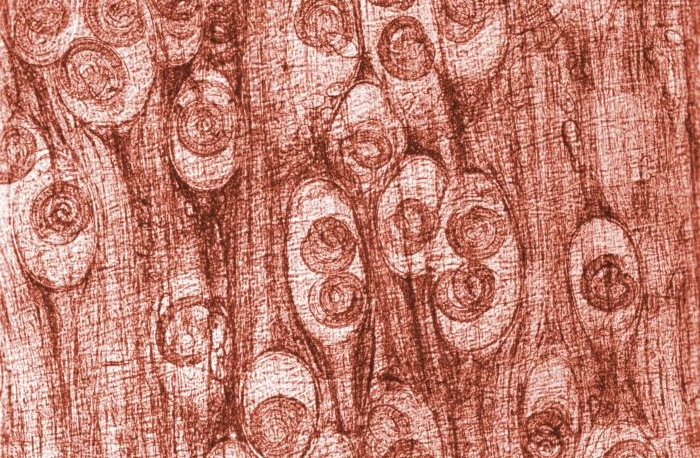Welcome back to “Shedding Light on NTDs”! This week, we are looking at Chagas disease, also known as American trypanosomiasis, which is a parasitic disease that is only found in the North and South America. The disease is spread through triatomine bugs, most commonly referred to as kissing bugs, due to its tendency to take blood meals on the face of animals. It is a vector predominately prevalent in Central and South America but is increasingly found in the United States and globally.
The Trypanosoma cruzi parasite lives in the digestive system of kissing bugs and is spread through their bite. During the night, the bugs often bite and feed on the faces of humans and other animals, giving them their distinct name as a kissing bug. After finishing its blood meal, the bug may defecate in or around the open wound. The parasite is able to enter the host organism as the host unknowingly scratches the wound or rubs their eyes, pushing the feces into their blood stream [1]. The parasite can be transmitted to humans and animals, including dogs, non-human primates, opossums, woodrats, armadillos, coyotes, mice, raccoons, skunks, and foxes [2].
In humans, Chagas disease exists in two phases: acute and chronic. The acute phase typically goes unnoticed because it is either symptom-free or has very mild symptoms, including fever, fatigue, body aches, headaches and rash [1]. The most noticeable marker of acute disease is called Romaña’s sign, which includes swelling of the eyelid where the bug typically bites. Most acute symptoms resolve on their own within a few weeks or with antibiotic treatment [1]. Approximately 30% of Chagas cases develop into the chronic disease phase if untreated, though researchers are still investigating why most cases lie dormant while the remaining develop into severe disease [1, 2]. The chronic phase can stay latent in the body for years or even decades, which leads to difficulty in effectively diagnosing the disease unless you are specifically looking for it. If the chronic phase develops into symptoms, it is characterized by cardiac and intestinal complications, including cardiomyopathy, cardiac arrest or enlarged colon and esophagus [1]. Untreated, Chagas disease can be fatal [1].
Chagas disease is often overlooked because of its vague clinical presentation. In its acute phase, the symptoms of infection could be confused with many other illnesses. Conditions like fever and fatigue are associated with hundreds of other conditions, so the likelihood of recognizing Chagas without an obvious bite wound can be difficult. Furthermore, when a person presents with cardiomyopathy or other heart-related illnesses, physicians rightly treat the issue at hand rather than running immediately the diagnostics for identifying the chronic phase of a tropical disease. Taking the non-disease-specific symptoms of Chagas disease into consideration with its long periods of latency in the body, it is not surprising that it can be overlooked if a physician is not specifically testing for Chagas.
The US Center for Disease Control and Prevention (CDC) estimates that over eight million people in the Americas are infected with Chagas disease and most of them are unaware of their condition [1]. Most cases occur in rural regions of Mexico, Central and South America, but there are cases that occur in the United States, particularly in Texas, California, Arizona and New Mexico and states along the southern border [1]. Research conducted by Texas A&M University showed that kissing bugs are found in 28 states in the United States and approximately 50% carry the Trypanosoma cruzi parasite [3]. Interestingly, veterinarians in southern Texas have seen an increase in Chagas disease in dogs. This increase in the number of infected dogs should act as a sentinel surveillance indicator – it would not be surprising if there is an increase in human cases over time as exposure to kissing bugs changes. The burden of Chagas disease in the United States is still relatively unknown. There are estimates between 300,000 and up to eight million, in the case of the CDC, however there is no consistent reporting system for the disease [4]. Some states, like Texas, have made Chagas disease a reportable disease, but it is still largely unreported and untested across the country [4]. Globally, the most recently reported Chagas outbreak occurred in Venezuela in April 2018, presumably through oral transmission of the parasite [5]. There were 45 suspected cases of acute Chagas disease and five reported fatalities in the village Puerto Nuevo, Libertador [5].
The best way to prevent Chagas transmission is through vector control, however, once again we are faced with the reality that those most impacted by the disease have little control over their living environment. In the remote rural regions of Central and South America, families live in homes that provide the perfect breeding grounds and entry points for kissing bugs. Dark, damp spaces give the bugs plenty of places to hide and at night, families that co-sleep give the bugs plenty of options to continue feeding in one space, as the bugs are attracted to carbon dioxide and heat [2]. Additionally, the bugs can fly longer distances, which gives them plenty of opportunities to spread and create new colonies that can spread disease. Furthermore, the best treatment for Chagas disease requires early detection and medical access. With limited healthcare access, a person who has little to no symptoms is not going to seek care if it requires extensive travel and is financially impractical, especially if the symptoms are mild or only last a short time.
Chagas is also difficult to control because of the wide range of species that contract the parasite. This creates a cycle where animals and kissing bugs continually spread the parasite, making it difficult to eradicate. Luckily, there are many Chagas vaccines in development, which provide a new hope for controlling the disease and its spread. The World Health Organization (WHO), in partnership with many influential global organizations, released the London Declaration on Neglect Tropical Diseases, which aims to control or eliminate NTDs and to provide treatment to as many people as possible if they are infected [6]. For Chagas, their goal is to control the disease and its spread by 2020, while being realistic that elimination will take a greater amount of time to adequately control the spread of Chagas to all animals [6].
Sources:
[1] https://www.cdc.gov/parasites/chagas/gen_info/detailed.html
[2] http://kissingbug.tamu.edu/
[3] http://www.kristv.com/story/38369673/uptick-in-chagas-disease-in-south-texas
[4] http://kissingbug.tamu.edu/FAQ/
[5] http://outbreaknewstoday.com/chagas-outbreak-kills-five-sickens-dozens-tachira-venezuela-44325/
[6] http://unitingtocombatntds.org/ntds/chagas-disease/

